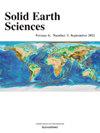Enhancing reservoir landslide displacement prediction with crack width data integration: A case study of the Daping landslide
IF 2
4区 地球科学
Q3 GEOSCIENCES, MULTIDISCIPLINARY
引用次数: 0
Abstract
Existing studies on predicting reservoir landslide displacements primarily focus on rainfall and reservoir water level (RWL) as the main factors influencing landslide movement. However, these studies overlook the potential role of crack width, even though landslide cracks are critical indicators of landslide formation and movement. Currently, no predictive models in this domain have integrated crack width alongside rainfall and RWL. In response to this gap, this study investigates the predicative performance of models that combines crack width, rainfall and RWL as the set of input factors for predicting temporal variations in the displacements of the Daping landslide within the Three Gorges Reservoir Area. The multiple wavelet coherence (MWC) method is used to determine optimal time lags between the combined input factors (i.e., rainfall, RWL and/or crack width) and the output (i.e., displacement). The raw data of these input factors within these time lags are integrated as the inputs to displacement prediction models during both training and prediction phases. Commonly used deep learning models, such as the deep neural network, gated recurrent unit, bidirectional long short-term memory and transformer architectures, are adopted in our experiment. Experimental results show that incorporating crack width data improves the accuracy of transient landslide displacement predictions compared to models that exclude crack width data, for the adopted prediction models.
利用裂缝宽度数据集成加强水库滑坡位移预测——以大坪滑坡为例
现有的水库滑坡位移预测研究主要将降雨和水库水位作为影响滑坡运动的主要因素。然而,这些研究忽略了裂缝宽度的潜在作用,即使滑坡裂缝是滑坡形成和运动的关键指标。目前,该领域的预测模型还没有将裂缝宽度与降雨量和RWL结合起来。针对这一缺陷,本文研究了以裂缝宽度、降雨和RWL为输入因子的模型对三峡库区大坪滑坡位移时间变化的预测性能。多小波相干(MWC)方法用于确定组合输入因素(即降雨、RWL和/或裂缝宽度)与输出因素(即位移)之间的最佳滞后时间。在训练和预测阶段,将这些输入因素在这些时间滞后内的原始数据作为位移预测模型的输入。我们的实验采用了常用的深度学习模型,如深度神经网络、门控循环单元、双向长短期记忆和变压器结构。实验结果表明,对于所采用的预测模型,与不含裂缝宽度数据的模型相比,纳入裂缝宽度数据提高了瞬态滑坡位移预测的准确性。
本文章由计算机程序翻译,如有差异,请以英文原文为准。
求助全文
约1分钟内获得全文
求助全文
来源期刊

Solid Earth Sciences
GEOSCIENCES, MULTIDISCIPLINARY-
CiteScore
3.60
自引率
5.00%
发文量
20
审稿时长
103 days
 求助内容:
求助内容: 应助结果提醒方式:
应助结果提醒方式:


